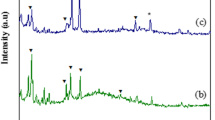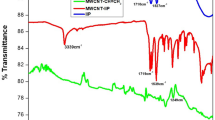Abstract
Adsorption membranes have the widespread and large scale use for pollution removal with promising prospects and better efficacy than powder adsorbents. However, the low adsorption capacity and non-selectivity, reusability hindered its application. In this work, commercial carbon felt (CF) functionalized with molecularly imprinted polymers (CF-MIP) was prepared to address the environmental issues brought by bisphenol A (BPA) in aqueous water. MIPs with low cost, good selectivity, long stability and reusability were tailored on the three-dimensional carbon felt (CF). The parameters including the solvents, cross-linker amount and the polymerization time for the preparation of CF-MIM as well as the selectivity and reusability of CF-MIM have been studied. The Pseudo-second-order kinetic and Langmuir isotherm model presented the most optimal fit to the experimental data in comparison to other models. The CF-MIM had a high binding capacity of 27.81 mg/g and retaining 80% of its original adsorption ability after five reuse cycles. This work will promote the development of functional CF with good selectivity and considerable stability for environmental application.
Graphical abstract







Similar content being viewed by others
Data availability
The data that support the findings of this study are available from the corresponding authors upon reasonable request.
References
Bhatnagar A, Anastopoulos I (2017) Adsorptive removal of bisphenol A (BPA) from aqueous solution: a review. Chemosphere 168:885. https://doi.org/10.1016/j.chemosphere.2016.10.121
Giulivo M, Lopez M, de Alda E, Capri DB (2016) Human exposure to endocrine disrupting compounds: their role in reproductive systems, metabolic syndrome and breast cancer a review. Environ Res 151:251. https://doi.org/10.1016/j.envres.2016.07.011
Balakrishnan A, Chinthala M, Polagani RK, Vo D-VN (2023) Removal of tetracycline from wastewater using g-C3N4 based photocatalysts: a review. Environ Res. 216:114660. https://doi.org/10.1016/j.envres.2022.114660
Noszczynska M, Piotrowska-Seget Z (2018) Bisphenols: Application, occurrence, safety, and biodegradation mediated by bacterial communities in wastewater treatment plants and rivers. Chemosphere 201:214. https://doi.org/10.1016/j.chemosphere.2018.02.179
Yuan X, Chen K, Zheng F et al (2023) Low-dose BPA and its substitute BPS promote ovarian cancer cell stemness via a non-canonical PINK1/p53 mitophagic signaling. J Hazard Mater. 452:131288. https://doi.org/10.1016/j.jhazmat.2023.131288
Adegoke KA, Olagunju AO, Alagbada TC et al (2022) Adsorptive removal of endocrine-disrupting chemicals from aqueous solutions: a review. Water Air Soil Pollut. 233:38. https://doi.org/10.1007/s11270-021-05405-8
Tarafdar A, Sirohi R, Balakumaran PA et al (2022) The hazardous threat of bisphenol A: toxicity, detection and remediation. J Hazard Mater 423:127097. https://doi.org/10.1016/j.jhazmat.2021.127097
Chen Z-H, Liu Z, Hu J-Q et al (2020) β-Cyclodextrin-modified graphene oxide membranes with large adsorption capacity and high flux for efficient removal of bisphenol A from water. J Membr Sci 595:117510. https://doi.org/10.1016/j.memsci.2019.117510
Zorzo CF, Inticher JJ, Borba FH et al (2021) Oxidative degradation and mineralization of the endocrine disrupting chemical bisphenol-A by an eco-friendly systembased on UV-solar/H2O2 with reduction of genotoxicity and cytotoxicity levels. Sci Total Environ. 770:145296. https://doi.org/10.1016/j.scitotenv.2021.145296
Sadeghzadeh S, Ghobadi Nejad Z, Ghasemi S, Khafaji M, Borghei SM (2020) Removal of bisphenol A in aqueous solution using magnetic cross-linked laccase aggregates from Trametes hirsuta. Bioresour Technol 306:123169. https://doi.org/10.1016/j.biortech.2020.123169
Azizi D, Arif A, Blair D et al (2022) A comprehensive review on current technologies for removal of endocrine disrupting chemicals from wastewaters. Environ Res 207:112196. https://doi.org/10.1016/j.envres.2021.112196
Godiya CB, Park BJ (2022) Removal of bisphenol A from wastewater by physical, chemical and biological remediation techniques a review. Environ Chem Lett 20:1801. https://doi.org/10.1007/s10311-021-01378-6
Supong A, Bhomick PC, Baruah M, Pongener C, Sinha UB, Sinha D (2019) Adsorptive removal of Bisphenol A by biomass activated carbon and insights into the adsorption mechanism through density functional theory calculations. Sust Chem Pharm 13:100159. https://doi.org/10.1016/j.scp.2019.100159
Vakili M, Mojiri A, Kindaichi T et al (2019) Cross-linked chitosan/zeolite as a fixed-bed column for organic micropollutants removal from aqueous solution, optimization with RSM and artificial neural network. J Environ Manag 250:109434. https://doi.org/10.1016/j.jenvman.2019.109434
Zhang Y, Yuan ZL, Deng XY et al (2022) Metal-organic framework mixed-matrix membrane-based extraction combined HPLC for determination of Bisphenol A in milk and milk packaging. Food Chem 386:132753. https://doi.org/10.1016/j.foodchem.2022.132753
Xing W, Ma Z, Wang C et al (2021) Metal-organic framework based molecularly imprinted nanofiber membranes with enhanced selective recognition and separation performance: a multiple strengthening system. Sep Purif Technol 278:119624. https://doi.org/10.1016/j.seppur.2021.119624
Pichon V, Chapuis-Hugon F (2008) Role of molecularly imprinted polymers for selective determination of environmental pollutants–a review. Anal Chim Acta 622:48. https://doi.org/10.1016/j.aca.2008.05.057
Zhu Y, Wang K, Pan Z et al (2022) Fabrication of sustainable boronate affinity membrane derived from rape pollen biomass and cellulose acetate for the selective separation of shikimic acid. ACS Sustain Chem Eng 11:322. https://doi.org/10.1021/acssuschemeng.2c05632
Cui Y, Chen Y, Ding L (2021) Fabrication of dual responsive imprinted materials of magnetic and solvent and their solvent-regulated binding performance for Bisphenol A. Chem Eng J 425:131605. https://doi.org/10.1016/j.cej.2021.131605
Xie X, Ma X, Guo L et al (2019) Novel magnetic multi-templates molecularly imprinted polymer for selective and rapid removal and detection of alkylphenols in water. Chem Eng J 357:56. https://doi.org/10.1016/j.cej.2018.09.080
Gupta S, Chakraborty M, Murthy ZVP (2014) Performance study of hollow fiber supported liquid membrane system for the separation of bisphenol A from aqueous solutions. J Ind Eng Chem 20:2138. https://doi.org/10.1016/j.jiec.2013.09.043
Yoshikawa M, Tharpa K, Dima SO (2016) Molecularly imprinted membranes: past, present, and future. Chem Rev 116:11500. https://doi.org/10.1021/acs.chemrev.6b00098
Fan J-P, Cheng Y-T, Zhang X-H et al (2020) Preparation of a novel mixed non-covalent and semi-covalent molecularly imprinted membrane with hierarchical pores for separation of genistein in radix puerariae lobatae. React Funct Polym 146:104439. https://doi.org/10.1016/j.reactfunctpolym.2019.104439
Lu J, Qin Y, Li C et al (2021) Irregular dot array nanocomposite molecularly imprinted membranes with enhanced antibacterial property: synergistic promotion of selectivity, rebinding capacity and flux. Chem Eng J 405:126716. https://doi.org/10.1016/j.cej.2020.126716
Vieira WT, de Farias MB, Spaolonzi MP, da Silva MGC, Vieira MGA (2020) Removal of endocrine disruptors in waters by adsorption, membrane filtration and biodegradation: a review. Environ Chem Lett 18:1113. https://doi.org/10.1007/s10311-020-01000-1
Yang Z, Qin T, Niu Y et al (2020) Flexible visible-light-driven photoelectrochemical biosensor based on molecularly imprinted nanoparticle intercalation-modulated graphene fiber for ultrasensitive urea detection. Carbon 157:457. https://doi.org/10.1016/j.carbon.2019.10.061
Huang J, Liu Z, Huang D, Jin T, Qian Y (2022) Efficient removal of uranium (VI) with a phytic acid-doped polypyrrole/ carbon felt electrode using double potential step technique. J Hazard Mater 433:128775. https://doi.org/10.1016/j.jhazmat.2022.128775
Javed H, Luong DX, Lee C-G, Zhang D, Tour JM, Alvarez PJJ (2018) Efficient removal of bisphenol-a by ultra-high surface area porous activated carbon derived from asphalt. Carbon 140:441. https://doi.org/10.1016/j.carbon.2018.08.038
Cui Y, He Z, Xu Y, Su Y, Ding L, Li Y (2021) Fabrication of molecularly imprinted polymers with tunable adsorption capability based on solvent-responsive cross-linker. Chem Eng J 405:126608. https://doi.org/10.1016/j.cej.2020.126608
Jakobczyk P, Skowierzak G, Kaczmarzyk I et al (2022) Electrocatalytic performance of oxygen-activated carbon fibre felt anodes mediating degradation mechanism of acetaminophen in aqueous environments. Chemosphere 304:135381. https://doi.org/10.1016/j.chemosphere.2022.135381
Liu Y, Zhang Y, Niu J et al (2023) Selective fluorescent probe for sensitive determination of Bisphenol A based on molecularly imprinted polymers decorated carbon dots derived from citric acid and ethylenediamine. Chemosphere 324:138303. https://doi.org/10.1016/j.chemosphere.2023.138303
Yu C, He W, Yan Y et al (2022) A deep insight for TBBPA imprinting on PVP-assisted separation membrane: Elucidation of detailed chemical transition in membrane preparation and imprinting process. Chem Eng J. 436:135024. https://doi.org/10.1016/j.cej.2022.135024
Leng L, Wei L, Xiong Q et al (2020) Use of microalgae based technology for the removal of antibiotics from wastewater: a review. Chemosphere 238:124680. https://doi.org/10.1016/j.chemosphere.2019.124680
Tan SL, El Meragawi S, Majumder M, Lau EV (2023) Superhydrophilic and underwater superoleophobic Graphene oxide-Phytic acid membranes for efficient separation of oil-in-water emulsions. Sep Purif Technol 314:123577. https://doi.org/10.1016/j.seppur.2023.123544
Zhou T, Ding L, Che G, Jiang W, Sang L (2019) Recent advances and trends of molecularly imprinted polymers for specific recognition in aqueous matrix: preparation and application in sample pretreatment. TrAC Trends Anal Chem 114:11. https://doi.org/10.1016/j.trac.2019.02.028
Jiang HR, Shyy W, Ren YX, Zhang RH, Zhao TS (2019) A room-temperature activated graphite felt as the cost-effective, highly active and stable electrode for vanadium redox flow batteries. Appl Energy 233–234:544. https://doi.org/10.1016/j.apenergy.2018.10.059
Yu L, Lin F, Xu L, Xi J (2019) P-doped electrode for vanadium flow battery with high-rate capability and all-climate adaptability. J Energy Chem 35:55. https://doi.org/10.1016/j.jechem.2018.11.004
Hu Z, Miao Z, Xu Z et al (2022) Carbon felt electrode modified by lotus seed shells for high-performance vanadium redox flow battery. Chem Eng J 450:138377. https://doi.org/10.1016/j.cej.2022.138377
Cui Y, Ding J, Su Y, Ding L (2023) Facile construction of magnetic hydrophilic molecularly imprinted polymers with enhanced selectivity based on dynamic non-covalent bonds for detecting tetracycline. Chem Eng J 452:139291. https://doi.org/10.1016/j.cej.2022.139291
Xing W, Yan Y, Wang C et al (2022) MOFs self-assembled molecularly imprinted membranes with photoinduced regeneration ability for long-lasting selective separation. Chem Eng J 437:135128. https://doi.org/10.1016/j.cej.2022.135128
Zhang Y, Zhang X, Wang S (2023) Recent advances in the removal of emerging contaminants from water by novel molecularly imprinted materials in advanced oxidation processes-a review. Sci Total Environ 883:163702. https://doi.org/10.1016/j.scitotenv.2023.163702
Deng F, Li Y, Luo X, Yang L, Tu X (2012) Preparation of conductive polypyrrole/TiO2 nanocomposite via surface molecular imprinting technique and its photocatalytic activity under simulated solar light irradiation. Colloids Surf A 395:183. https://doi.org/10.1016/j.colsurfa.2011.12.029
Niu J, Liu H, Wang X, Wu D (2019) Molecularly imprinted phase-change microcapsule system for bifunctional applications in waste heat recovery and targeted pollutant removal. ACS Appl Mater Interfaces 11:37644. https://doi.org/10.1021/acsami.9b11856
Tripathy SS, Raichur AM (2008) Abatement of fluoride from water using manganese dioxide-coated activated alumina. J Hazard Mater 153:1043. https://doi.org/10.1016/j.jhazmat.2007.09.100
Yang H, Liu H-B, Tang Z-S et al (2021) Synthesis, performance, and application of molecularly imprinted membranes: a review. J Environ Chem Eng 9:106352. https://doi.org/10.1016/j.jece.2021.106352
Balakrishnan A, Appunni S, Chinthala M et al (2023) Chitosan-based beads as sustainable adsorbents for wastewater remediation: a review. Environ Chem Lett 21:1881. https://doi.org/10.1007/s10311-023-01563-9
Schiano ME, Sodano F, Magli E et al (2023) Quantitative determination of BPA, BPB, BPF and BPS levels in canned legumes from Italian market. Food Chem 416:135642. https://doi.org/10.1016/j.foodchem.2023.135642
Sun F, Huang Y, Chen H et al (2023) BPA and its alternatives BPF and BPAF exaggerate hepatic lipid metabolism disorders in male mice fed a high fat diet. Sci Total Environ 867:161521. https://doi.org/10.1016/j.scitotenv.2023.161521
Shen YZ, Guan J, Ma C, Shu Y, Xu Q, Hu XY (2022) Competitive displacement triggering DBP photoelectrochemical aptasensor via cetyltrimethylammonium bromide bridging aptamer and perovskite. Anal Chem 94:1742. https://doi.org/10.1021/acs.analchem.1c04348
Fan J-P, Li L, Tian Z-Y et al (2014) A novel free-standing flexible molecularly imprinted membrane for selective separation of synephrine in methanol–water media. J Membr Sci 467:13. https://doi.org/10.1016/j.memsci.2014.05.018
Acknowledgements
This research was funded by NSFC (22076161, 21675140 and 21705141), the Talent Support Program of Yangzhou University, Yangzhou University Interdisciplinary Research Foundation for Chemistry Discipline of Targeted Support (yzuxk202009), the project funded by the PAPD and TAPP.
Author information
Authors and Affiliations
Contributions
YY: Data curation, Investigation, Methodology, Writing-Original Draft. WZX: Data curation, investigation and methodology. YZS: Formal analysis, investigation and methodology. KPN: Formal analysis, investigation. QX: Writing-review&editing, Project administration, Funding acquisition, Super vision, Visualization, Conceptualization. XYH: Project administration, Resources, Supervision.
Corresponding author
Ethics declarations
Conflict of interest
The authors declare that there is no confict of interest.
Ethical approval
Not applicable.
Additional information
Handling Editor: Andréa de Camargo.
Publisher's Note
Springer Nature remains neutral with regard to jurisdictional claims in published maps and institutional affiliations.
Supplementary Information
Below is the link to the electronic supplementary material.
Rights and permissions
Springer Nature or its licensor (e.g. a society or other partner) holds exclusive rights to this article under a publishing agreement with the author(s) or other rightsholder(s); author self-archiving of the accepted manuscript version of this article is solely governed by the terms of such publishing agreement and applicable law.
About this article
Cite this article
Yao, Y., Xie, W., Shen, Y. et al. Carbon felt tailored with artificial recognition elements: an effective membrane for bisphenol A adsorption and removal. J Mater Sci 58, 18046–18059 (2023). https://doi.org/10.1007/s10853-023-09164-1
Received:
Accepted:
Published:
Issue Date:
DOI: https://doi.org/10.1007/s10853-023-09164-1




